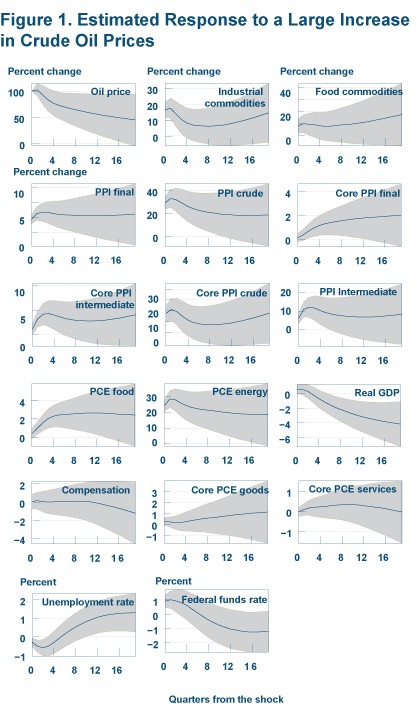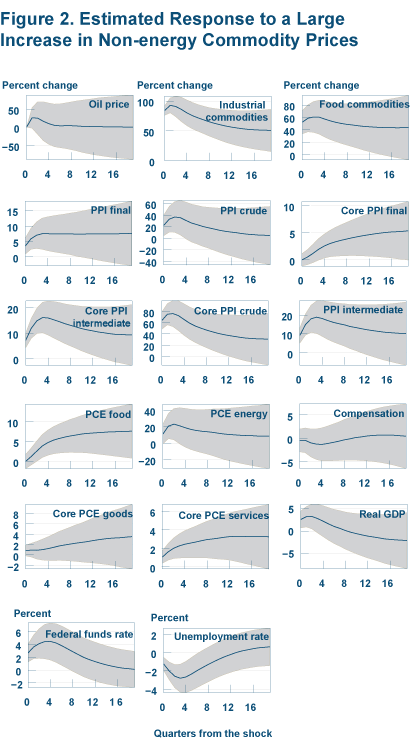- Share
Food and Energy Price Shocks: What Other Prices Are Affected?
Sharp rises in energy and other commodity prices have recently ignited concerns about inflation. Will these price increases spill over to other prices more generally? We study the typical responses of different price shocks and assess whether the recent behavior of producer and consumer prices is consistent with historical norms. Our analysis shows that the behavior of various producer and consumer prices since late 2009 has generally matched up with historical patterns. Overall, our findings suggest that effects of the recent energy and commodity price shocks on core consumer prices will be modest going forward.
The views authors express in Economic Commentary are theirs and not necessarily those of the Federal Reserve Bank of Cleveland or the Board of Governors of the Federal Reserve System. The series editor is Tasia Hane. This paper and its data are subject to revision; please visit clevelandfed.org for updates.
Sharp rises in energy and other commodity prices have recently ignited concerns about inflation. Will these price increases spill over to other prices more generally? We study the typical responses of different price shocks and assess whether the recent behavior of producer and consumer prices is consistent with historical norms. Our analysis shows that the behavior of various producer and consumer prices since late 2009 has generally matched up with historical patterns. Overall, our findings suggest that effects of the recent energy and commodity price shocks on core consumer prices will be modest going forward.
Sharp increases in energy and other commodity prices earlier this year have raised concerns about the potential for broader price effects. Broader effects will occur to the extent that rising energy and other commodity prices push up the costs of producing a wide array of other goods, and firms are forced to raise prices. Some such effects are already evident. For example, in the past year, producer prices for intermediate goods have risen nearly 12 percent, and prices for core intermediate goods have increased more than 7 percent.
However, significant effects on many consumer prices are harder to discern: excluding food and energy, consumer prices have increased only about 1.5 percent in the past 12 months. Looking ahead, the effects of this year’s increases in energy and other commodity prices on headline consumer price inflation and non-food and non-energy inflation are likely to be temporary and modest (see Beauchemin 2011 for the analysis).
How can it be that energy and commodity price increases have affected consumer prices less than they have affected other (non-consumer) prices, such as those for intermediate goods? To answer this question, we begin by briefly sketching a conceptual framework that ties together different types of prices in a chain of production. We then use a forecasting model to examine the transmission of changes in oil and non-energy commodity prices to a range of producer and consumer prices. More specifically, we study the typical responses of different prices to shocks to energy and other commodity prices and assess whether the recent behavior of producer and consumer prices is consistent with historical norms. We also present forecasts for the remainder of 2011 and 2012.
Our analysis shows that the effects of shocks to energy and other commodity prices should be expected to be larger for prices of goods earlier in the production chain. For example, these shocks should be expected to cause sharper responses in producer prices than consumer prices. Our analysis also shows that, since late 2009, the response of various producer and consumer prices to rising energy and other commodity prices has generally matched up with historical patterns.
Conceptual Framework: Chain of Production
Producer and consumer price indexes can be viewed as prices of different goods along a chain of production, in which producer prices capture the prices of the input goods used to produce final goods that are sold to consumers.1 For example, the producer price index (PPI) for crude materials includes the price of iron, while the intermediate goods PPI includes the prices of steel mill products, which are produced using iron. The finished goods PPI includes the prices of machine tools, which are constructed from steel mill products. Finally, the price index for personal consumption expenditures (PCE price index) includes the prices paid by consumers for goods, such as hand drills, which are produced using machine tools.
With firms in the economy setting their prices at some markup over their costs of production, changes in the costs of inputs may cause firms to change the prices of the goods they produce. For example, a sharp increase in oil prices will increase production costs for a firm that makes petroleum-based plastics and may lead the firm to increase its price. In turn, a firm that produces a good that includes the plastics may experience a cost increase and may increase its price in response.2
In practice, though, the ties among producer and consumer prices may not be quite as strong as this simple conceptual framework suggests. The reason is that the available measures of producer and consumer prices differ importantly in definition. The PPIs measure only prices of goods produced in the U.S., while the PCE price index tracks the prices consumers pay for goods and services that have been produced in the U.S. or imported. These differences may mean that some changes in producer prices will not show up in consumer prices. For example, if the prices of imported goods fall while the PPI increases, the PCE price index might not change much on net. Similarly, if the services price component of the PCE price index doesn’t change as the PPI increases, the overall PCE price index will rise considerably less than the PPI, reflecting the large share of services in consumer spending (roughly 65 percent).
Forecasting Model
To empirically assess the ties among producer and consumer prices, we use an expanded version of the forecasting model described in Ken Beauchemin’s Commentary, “Shocks and the Economic Outlook.” Our model is a 17-variable vector autoregression, which consists of equations relating the current value of each variable to past values of all variables.
The model variables include:
- Producer price indexes (PPI) for crude materials, intermediate goods, and the finished goods core (non-food and non-energy)
- Core price indexes for consumer goods and consumer services
- The price index for consumer energy
- The price index for consumer food
- The price of oil
- The price index (spot) of commodity prices, raw industrials
- The price index (spot) of commodity prices, foodstuffs
- Real GDP
- The unemployment rate
- Compensation per hour, nonfarm business sector
- The federal funds rate.
This model is similar to one developed by Giannone, Lenza, Momferatou, and Onorante (2010) for the purpose of forecasting inflation in the euro area and examining the influences of various inflation determinants. In general, vector autoregressive models have a long tradition in macroeconomic forecasting and have been shown to be effective for that purpose.
Typical Effects of Energy and Commodity Prices
We begin by using estimates of our model to assess the typical responses of producer and consumer prices to shocks to oil prices and non-energy commodity prices.
Figure 1 traces out the estimated responses of prices and the other variables in the model to a large increase in crude oil prices, showing the point estimate of the response and the 95 percent confidence band around it. Our estimates represent the percentage point response of each variable to the shock to oil prices. The shock to oil prices is defined as a 100 percent increase at the time of impact, broadly consistent with the approximate doubling of oil prices that actually occurred from early 2009 to early 2011.

The results in figure 1 indicate that the effects of an oil price shock diminish over the chain of production, being largest for PPIs for crude materials, next largest for PPIs for intermediate goods, and more modest for PPIs for finished goods. For example, a few quarters after the oil price shock occurs, the PPIs for crude, intermediate, and final goods (the headline measures, which include food and energy prices) rise by about 30 percent, 10 percent, and 6 percent, respectively. The estimates also show that the headline measures of producer prices respond significantly more than do the core measures.
Consistent with the findings of other researchers, our model estimates also indicate that the historical effects of energy prices on a broad range of consumer prices have generally been modest. Indeed, in figure 1, the responses of core consumer goods and services prices as measured by the PCE indexes are small enough that, in a statistical sense, they are not significantly different from zero.3 However, oil price increases do cause consumer food and energy prices to rise significantly. In our estimates, the approximate doubling of oil prices causes PCE food prices to rise about 2 percent and PCE energy prices to jump as much as 30 percent. The large oil price shock also causes a significant slowing of the economy, reducing the level of GDP by about 2 percent over the first two years following the shock.
Figure 2 reports the effects of a shock to non-energy commodity prices. Broadly, the responses of producer and consumer prices to a commodity price shock are similar to the responses to an oil price shock, in the following respects. First, the effects of the shock diminish over the chain of production. Second, headline PPIs respond more to commodity prices than do core PPIs. Third, the responses of core consumer prices are relatively modest.

Beyond those similarities, these commodity price shocks have modestly different effects on the prices of core PCE goods and services. The change in core PCE goods prices is not significantly different from zero (statistically speaking), but that of core PCE services prices is. Core services prices rise significantly, although modestly compared to PPI prices. Some supplementary analysis of more detailed PCE prices suggests this services response may reflect the effect of dollar depreciation (following the commodity price shock) on some components of services prices, such as foreign travel. Finally, the commodity price shock is associated with significant increases in consumer food and energy prices.
Recent Price Responses against Historical Norms
Building on our assessment of the typical responses of producer and consumer prices to energy and non-energy commodity price changes, we now use our forecasting model to determine whether the actual movements of prices in the last few years have been consistent with historical norms. More specifically, to set the historical norms, we turn the clock back to mid-2009, and we use the model to forecast producer and consumer prices from mid-2009 through the mid-2012, taking as given the actual paths of oil, non-energy commodity, and food prices.
These forecasted paths of producer and consumer prices are taken as the historical norms. They capture what the model implies should have happened to prices in response to the increases in oil, commodity, and food prices that actually occurred from the third quarter of 2009 through the second quarter of 2011. If the actual movements of consumer and producer prices since mid-2009 look similar to the forecasts from the model, we will judge the actual changes in prices to be consistent with historical norms.
Figure 3 reports the results in the form of fan charts, which show the observed value, the point forecast, and forecast confidence bands of 10 percent, 20 percent, 30 percent, etc., up to 90 percent. According to the forecasts, the recent behavior of producer and consumer prices has been consistent with historical norms. In almost all cases, the actual paths of producer and consumer prices lie within the forecast confidence bands from the model. For example, the actual rise in the headline and core PPIs for intermediate goods match up quite closely with the point forecast from the model, given the behavior of energy and commodity prices since mid-2009. The same applies to consumer food and energy prices. The most notable exception occurs with core PCE services prices, for which the actual increase in the price level has been much smaller than in the model’s forecast. Admittedly, this exception has no obvious explanation.

Conclusion
While the analysis in this article has focused on the rise in oil and commodity prices that occurred from 2009 through the early part of 2011, it remains to be seen how producer and consumer prices will evolve in response to the past increases in oil and commodity prices and more recent declines in oil and commodity prices. This analysis suggests declines in oil and commodity prices will slow producer prices more than most consumer prices. But only time will tell for sure.
Footnotes
- See Clark (1995) for a more detailed discussion of the chain of production. Return
- The relationships among producer and consumer prices are also likely to be more complicated than the simple conceptual framework suggests. The reason is that the relationships among U.S. industries are so intricate and complicated that it is impossible to separate industry-level prices into clear-cut crude, intermediate, and finished good categories, such that crude materials are used only to produce intermediate goods, which in turn are used only to produce finished goods. For example, items included in the crude materials category are often used to produce goods included in both the intermediate and finished goods categories. Accordingly, an increase in the prices of some crude materials may inflate the prices of both some intermediate and some finished goods. Return
- That said, some supplementary analysis of more detailed indexes of goods and services prices showed that some specific prices (such as transportation costs), which might be expected to be sensitive to energy and commodity prices, do in fact respond to the shocks we considered in our analysis. Return
References
- “Shocks and the Economic Outlook,” by Kenneth R. Beauchemin, 2011. Federal Reserve Bank of Cleveland, Economic Commentary, 2010-12.
- “Do Producer Prices Lead Consumer Prices?” by Todd E. Clark, 1995. Federal Reserve Bank of Kansas City, Economic Review, fourth quarter.
- “Short-Term Inflation Projections: A Bayesian Vector Autoregressive Approach,” by Domenico Giannone, Michele Lenza, Daphne Momferatou, and Luca Onorante. 2010. Center for Economic Policy Research, discussion paper, no. 7746.
Suggested Citation
Clark, Todd E., and Saeed Zaman. 2011. “Food and Energy Price Shocks: What Other Prices Are Affected?” Federal Reserve Bank of Cleveland, Economic Commentary 2011-14. https://doi.org/10.26509/frbc-ec-201114
This work by Federal Reserve Bank of Cleveland is licensed under Creative Commons Attribution-NonCommercial 4.0 International






